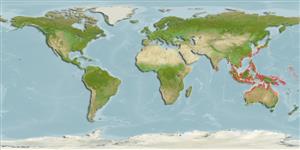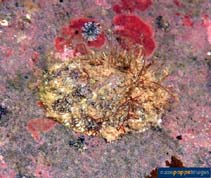Patelloida striata (Quoy & Gaimard, 1834)
Striate limpet| Native range | All suitable habitat | Point map | Year 2050 |

|
| This map was computer-generated and has not yet been reviewed. |
| Patelloida striata AquaMaps Data sources: GBIF OBIS |
Classification / Names Common names | Synonyms | CoL | ITIS | WoRMS
Gastropoda | Not assigned | Lottiidae
Environment: milieu / climate zone / depth range / distribution range Ecology
Benthic. Tropical
Distribution Countries | FAO areas | Ecosystems | Occurrences | Introductions
Indo-West Pacific: from India to the Philippines; north to Japan and south to Indonesia.
Length at first maturity / Size / Weight / Age
Maturity: Lm ? range ? - ? cm Max length : 5.0 cm SHL male/unsexed; (Ref. 349); common length : 4.0 cm SHL male/unsexed; (Ref. 349)
Life cycle and mating behavior Maturity | Reproduction | Spawning | Eggs | Fecundity | Larvae
Members of the order Patellogastropoda are mostly gonochoric and broadcast spawners. Life cycle: Embryos develop into planktonic trocophore larvae and later into juvenile veligers before becoming fully grown adults.
Main reference
References | Coordinator | Collaborators
Poutiers, J.M. 1998. (Ref. 349)
IUCN Red List Status (Ref. 130435)
CITES status (Ref. 108899)
Not Evaluated
CMS (Ref. 116361)
Not Evaluated
Threat to humans
Harmless
Human uses
Fisheries: subsistence fisheries
| FishSource |
Tools
More information
Internet sources
BHL | BOLD Systems | CISTI | DiscoverLife | FAO(Publication : search) | Fishipedia | GenBank (genome, nucleotide) | GloBI | Gomexsi | Google Books | Google Scholar | Google | PubMed | Tree of Life | Wikipedia (Go, Search) | Zoological Record
Estimates based on models
Preferred temperature
(Ref. 115969): 25.4 - 29.3, mean 28.6 (based on 1113 cells).
Price category
(Ref. 80766):
Unknown.



